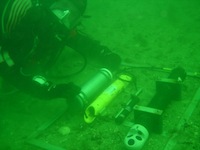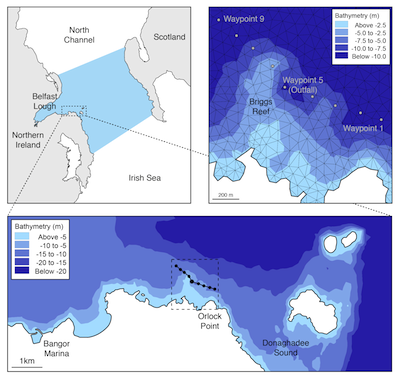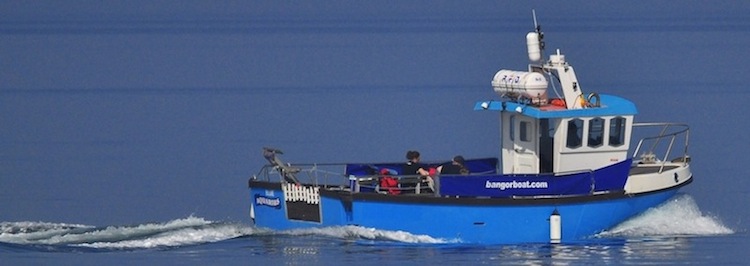Assessing the impact of sewage outfalls on macroalgae using coupled hydrodynamic and ecological models
In most natural systems macroalgal growth during summer is limited by nitrogen and so placement of macroalgal aquaculture facilities (seaweed farms) near anthropogenic sources of nutrients (e.g. sewage outfalls) has the potential to extend the growing season, and thus productivity of these farms.

An Aquadopp (ADCP) on the bottom near the diffuser (28/03/2012).

Belfast Lough Model Domain.
This project aimed to assess the feasibility of growing seaweed near a large sewage outfall near the entrance to Belfast Lough. To do this we developed, applied and validated a depth averaged hydrodynamic model of Belfast Lough using the MIKE by DHI software suite. We calibrated and validated this model using bed- and boat-mounted Acoustic Doppler Current Profilers (ADCPs), bottom-mounted digital pressure sensors, and long-term datasets available from the National Tide and Sea Level Facility.
On top of this hydrodynamic model we applied a Eulerian description of plume dispersal, parameterised with data collected with the support of the North Down Ards Waste Water Treatment Works, run by Veolia Water Limited. Using this model as a guide, we surveyed the area around the sewage outfall, making in situ measurements of nutrient concentrations, salinity and temperature and took samples for stable isotope analysis of benthic macroalgae (Laminaria hyperborea and Saccharina latissima).
Publications
Coupled hydrodynamic and wastewater plume models of Belfast Lough, Northern Ireland: A predictive tool for future ecological studies. Pritchard, D.W., Savidge G., Elsäßer, B. Marine Pollution Bulletin. For further information, see the Publications Page

On our way to dive the diffuser near the entrance to Belfast Lough (28/03/2012).